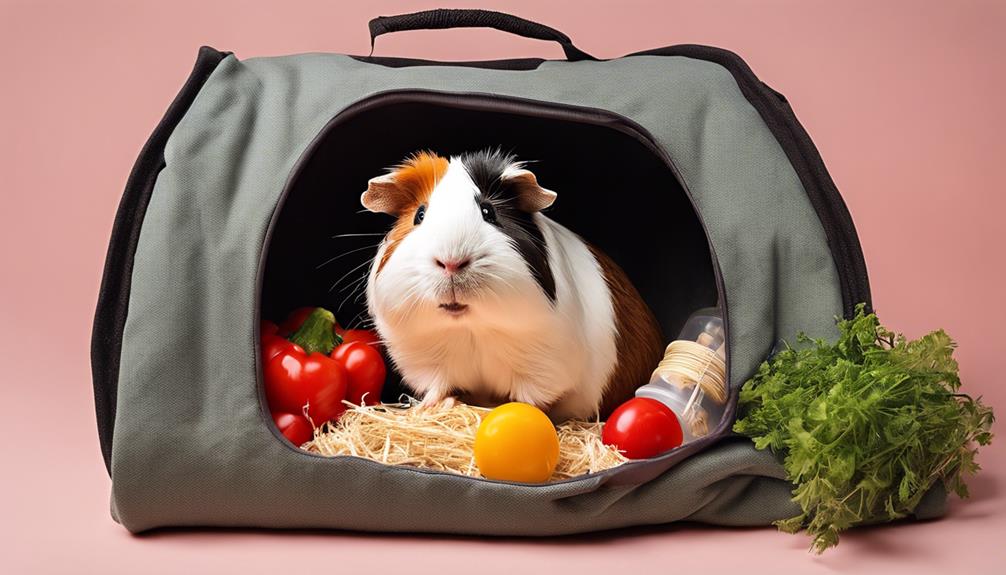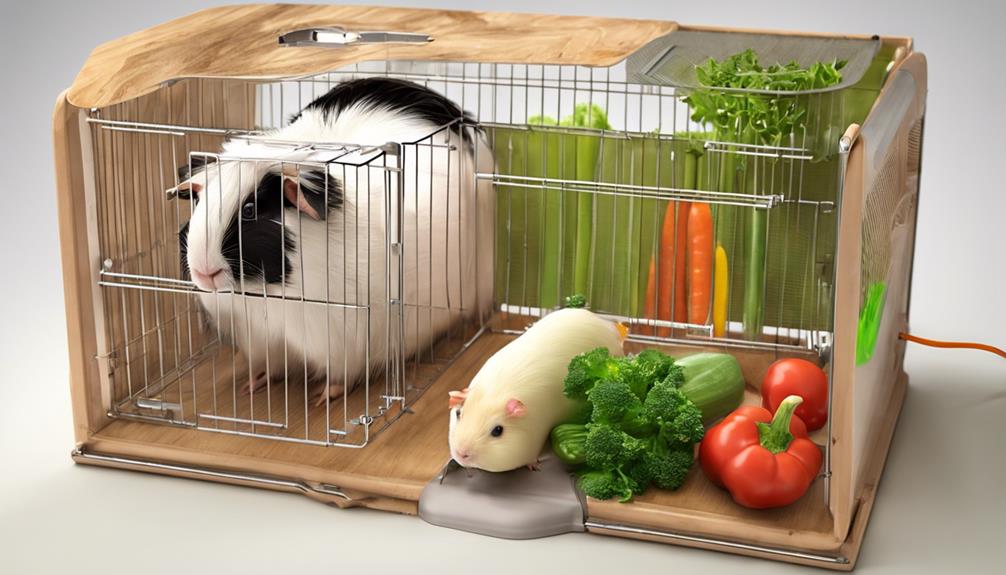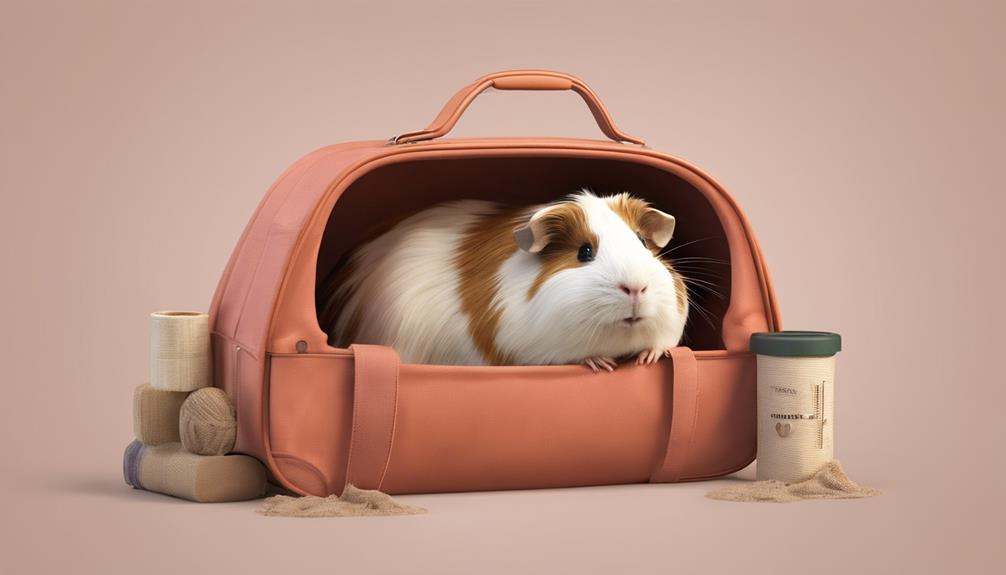How to Create a Comfortable Travel Environment for Guinea Pigs

Guinea pigs are sensitive animals that require a comfortable environment when traveling. To ensure their well-being during journeys, it is important to provide a safe and secure carrier that is well-ventilated and spacious enough for them to move around. Additionally, placing familiar bedding and a few favorite toys in the carrier can help reduce stress and make the journey more enjoyable for the guinea pigs. It is also essential to avoid sudden movements and loud noises during travel to keep the guinea pigs calm. Lastly, providing fresh food, water, and occasional breaks during long trips will help keep them healthy and happy throughout the journey.
Traveling with guinea pigs can be a rewarding experience for both you and your pets when done with their comfort and safety in mind.
Key Takeaways
- Choose carriers with secure latches and ample room for comfortable movement.
- Ensure proper ventilation and airflow to maintain good air quality.
- Pack supplies like water bottles, bedding, and snacks for hydration and comfort.
- Plan breaks with entertainment and have emergency kits ready for any unforeseen situations.
Choosing the Right Carrier
When selecting a carrier for your guinea pig, prioritize comfort and safety above all else. The carrier size is important to make sure your furry friend has enough space to move around comfortably during travel. Opt for a carrier that allows your guinea pig to stand up on its hind legs without its head touching the top and offers ample room for it to turn around easily.
Additionally, consider carriers with comfort features such as soft bedding or padding to provide a cozy environment for your pet. Look for carriers with secure latches to prevent any accidental openings during transit, making sure your guinea pig stays safe and secure throughout the journey.
Ensuring Proper Ventilation
Proper ventilation is vital for the well-being of guinea pigs during travel. Adequate airflow helps regulate temperature and guarantees a fresh supply of oxygen.
Understanding ventilation considerations and optimizing airflow in their enclosures are key aspects to contemplate for a comfortable journey.
Ventilation Considerations
Ensuring adequate ventilation is a crucial aspect to keep in mind when creating a comfortable travel environment for guinea pigs. Here are some key considerations:
- Air Quality: Maintain good air quality by providing proper ventilation to prevent the buildup of harmful gases.
- Ventilation Solutions: Explore options like adjustable vents or mesh windows to regulate airflow effectively.
- Avoid Direct Drafts: Position the travel carrier in a way that allows for airflow without subjecting the guinea pigs to direct drafts.
- Regular Checks: Guarantee ventilation systems are functioning correctly by conducting periodic inspections to guarantee a constant flow of fresh air.
Airflow in Enclosures
How can one optimize airflow within enclosures to guarantee the well-being of guinea pigs during travel?
Proper enclosure ventilation is essential for ensuring the comfort and health of guinea pigs on the go. When setting up the travel environment, it's important to ponder airflow management to prevent the buildup of stale air and maintain a fresh atmosphere.
Adequate ventilation helps regulate temperature, reduce humidity levels, and eliminate any potential odors that could stress the guinea pigs. By strategically placing ventilation holes or ensuring proper airflow within the enclosure, caregivers can create a safe and comfortable travel environment for their furry companions.
Packing Essential Supplies

As one prepares for a journey with their guinea pig companions, it's important to pack essential supplies thoughtfully. Items such as bedding, food, water bottles, and a first aid kit should be prioritized.
Proper food storage to maintain freshness and cleanliness is key to ensuring a smooth and comfortable travel experience for the furry travelers.
Essential Travel Items
To guarantee a stress-free travel experience for your guinea pigs, pack essential supplies that cater to their comfort and well-being. Here are four must-have items to include in your guinea pig's travel kit:
- Travel Water Bottles: Ensure your furry friends stay hydrated during the journey by providing a reliable water source.
- Bedding Options: Choose soft and comfortable bedding to keep your guinea pigs cozy and relaxed while traveling.
- Portable Hideaways: Offer your guinea pigs a safe and secure space to retreat to when they need privacy or comfort.
- Snack Varieties: Pack a selection of their favorite treats to keep them happy and content throughout the trip.
Proper Food Storage
For ideal travel preparation, ensuring proper food storage is paramount when packing essential supplies for your guinea pigs. Food safety is vital to keep your furry companions healthy and happy during the journey. Opt for airtight containers to maintain freshness and prevent any contamination.
Choose storage solutions that are compact and easy to transport, such as sealable bags or small plastic containers. Labeling the containers with the feeding schedule can help maintain a routine even while on the go. Be mindful of temperature variations and avoid exposing the food to direct sunlight or extreme heat.
Providing Adequate Bedding
Ensuring proper bedding is essential for creating a cozy and safe environment for guinea pigs during travel. When preparing for your furry companions' journey, here are some key points to take into account:
- Bedding Options: Choose soft, absorbent bedding such as fleece liners or paper-based substrates to provide a comfortable resting place for your guinea pigs.
- Cleaning Frequency: Regularly clean and change the bedding to maintain cleanliness and hygiene in the travel enclosure. Dirty bedding can lead to odor and discomfort for your pets.
- Comfortable Nesting Materials: Include cozy nesting materials like hay or shredded paper to help guinea pigs feel secure and relaxed during the trip.
- Cozy Hideaways: Provide small shelters or hideaways within the enclosure where your guinea pigs can retreat to rest or feel safe while on the road.
Planning Regular Breaks

Regularly incorporating short breaks into the travel itinerary allows guinea pigs to stretch their legs and stay refreshed throughout the journey. Planning rest stop locations strategically is important to guarantee the comfort and well-being of these small pets. When deciding on rest stops, opt for quiet and shaded areas away from noise and direct sunlight. This will help reduce stress and keep the guinea pigs calm during breaks. Additionally, providing exercise options during these breaks is essential to prevent stiffness and promote physical activity. Here are some exercise options that can be beneficial:
| Rest Stop Locations | Exercise Options |
|---|---|
| Pet-friendly parks | Enclosed playpen for running around |
| Quiet picnic areas | Tunnel or obstacle course for mental stimulation |
| Grass patches | Mini agility course with hurdles and ramps |
| Secluded corners | Interactive toys for playtime |
Monitoring Temperature and Humidity
To guarantee the well-being of guinea pigs during travel, attentively monitoring the temperature and humidity levels in their environment is essential. Here are four key points to take into account in this regard:
- Temperature Control: Make sure the travel environment isn't too hot or too cold for the guinea pigs. Keep the temperature within the range of 65-75°F (18-24°C) to prevent overheating or hypothermia.
- Humidity Levels: Maintain appropriate humidity levels between 30-70% to avoid respiratory issues or dehydration. Use a hygrometer to monitor humidity accurately.
- Travel Comfort: Create a cozy setting by lining the carrier with comfortable bedding, such as fleece or hay, to provide a soft and familiar environment for the guinea pigs.
- Environment Setup: Place the carrier away from direct sunlight and drafts to guarantee a stable and comfortable travel environment for the guinea pigs.
Minimizing Noise and Stress

Amidst the hustle and bustle of travel, it is important to create a serene and tranquil atmosphere for guinea pigs by minimizing noise and stress in their environment. Implementing calming techniques and noise reduction strategies can greatly contribute to a stress-free travel experience for these small pets.
To guarantee a comfortable journey for guinea pigs, consider the following tips:
| Calming Techniques | Noise Reduction |
|---|---|
| Gentle petting and soothing talk | Use blankets to muffle sound |
| Provide familiar bedding | Avoid loud music or voices |
| Maintain a consistent routine | Choose quieter travel routes |
| Offer favorite treats | Use a carrier with good ventilation |
| Use a soft, cozy carrier | Minimize sudden loud noises |
Preparing for Emergencies
In the midst of ensuring a peaceful travel environment for guinea pigs by minimizing noise and stress, it's essential to also prepare for emergencies to safeguard their well-being during the journey. Guinea pig owners should prioritize emergency preparedness and first aid to address any unforeseen situations effectively.
To create a safe travel environment, consider the following:
- Emergency Preparedness Kit: Assemble a kit with essentials like extra bedding, water, food, and any necessary medications.
- First Aid Supplies: Pack items such as gauze, antiseptic wipes, and styptic powder to handle minor injuries promptly.
- Safe Handling Procedures: Educate yourself on proper guinea pig handling techniques to prevent accidents or escapes during emergencies.
- Evacuation Plan: Have a plan in place in case evacuation becomes necessary; know where to go and how to transport your guinea pigs safely.
Frequently Asked Questions
How Can I Help My Guinea Pig Stay Calm During Long Car Rides?
When starting on long car rides, guinea pigs benefit from calming techniques and stress relief strategies. Providing entertainment options and travel companionship can help keep them calm and content throughout the journey, ensuring their well-being.
Are There Any Specific Foods or Treats I Should Bring for My Guinea Pig While Traveling?
When traveling with guinea pigs, it is crucial to pack healthy snacks like veggies and hay for nibbling. Don't forget hydration options such as a water bottle or fresh fruits. These treats will keep your furry friend happy and content during the journey.
Can I Use a Harness or Leash to Take My Guinea Pig for a Walk During Breaks?
While on breaks, a harness or leash can provide safe outdoor exploration for guinea pigs. However, indoor playtime also offers socialization opportunities without risks. It's wise to balance both activities to keep the guinea pig engaged and content during travel.
How Do I Handle Bathroom Breaks for My Guinea Pig While on the Road?
When handling potty breaks for a guinea pig on the road, one should prioritize consistency in their training routine. Accommodations like a portable litter box can help maintain cleanliness and comfort during travel.
What Should I Do if My Guinea Pig Becomes Agitated or Scared During the Journey?
When a guinea pig gets scared on the journey, it's essential to stay calm. Comforting strategies like gentle petting, soothing words, and creating a safe environment can help ease their stress. Understanding their needs is key.











